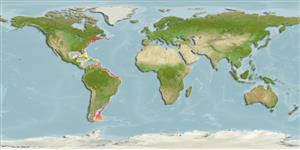>
Clupeiformes (Herrings) >
Engraulidae (Anchovies) > Engraulinae
Etymology: Engraulis: Greek, eggraulis, -eos = anchovy (Ref. 45335).
More on authors: Swain & Meek.
Environment: milieu / climate zone / ລະດັບຄວາມເລິກ / distribution range
ນິເວດວິທະຍາ
ສັດທະເລ pelagic-neritic; ລະດັບຄວາມເລິກ 124 - 282 m (Ref. 5951). Tropical; 45°N - 0°, 91°W - 46°W (Ref. 189)
Western Atlantic: Massachusetts south to Florida and the northeastern Gulf of Mexico - at least to about Mississippi sound, but not recorded elsewhere; Venezuelan coast to northern Brazil at 2°19'N.
ຂະໜາດ / ນ້ຳໜັກ / Age
ການຈະເລີນເຕັມໄວ: Lm ? range ? - ? cm
Max length : 15.5 cm TL ຕົວຜູ້/ບໍ່ມີເພດ; (Ref. 37032); common length : 8.0 cm TL ຕົວຜູ້/ບໍ່ມີເພດ; (Ref. 5217)
ຄີ (ໜາມ)ແຂງຢູ່ຫຼັງປາ (ທັງໝົດ) : 0; ຄີຫຼັງຂອງປາ (ຄີອ່ອນ) (ທັງໝົດ) : 13 - 16; ຄີ(ໜາມ) ແຂງຢູ່ຄີກົ້ນປາ
ກຸ່ມປາກະດູກແຂງ
ຄວາມຖີ່ຂອງກຸ່ມຖ່າຍທອດພັນ
ປາທີ່ມີການເຄື່ອນຍ້າຍຈາກທະເລໄປຫານ້ຳຈືດ ແລະນ້ຳຈືດຫາທະເລ
ປາທີ່ມີການເຄື່ອນຍ້າຍຈາກທະເລແລະໄປໄຂ່ຢູ່ນ້ຳຈືດ
ຄີກົ້ນຂອງປາ
ສັດທີ່ມີກະດູກສັນຫັຼງ
ການຖ່າຍທອດທາງກຳມະພັນຈາກພໍ່ແມ່ຫາລູກ: 0; ຄີກົ້ນຂອງປາ: 13 - 18. Hardly differs from European anchovy (see E. encrasicolus) and can be identified from that description. Differs from Atlantic species of Anchoviella by its much longer pseudobranch (more than eye diameter and reaching onto inner face of operculum); differs from Atlantic species of Anchoa in its short and blunt-tipped maxilla (cf. pointed and reaching onto pre-operculum or beyond) (Ref. 189).
Body shape (shape guide): elongated; Cross section: oval.
Common in shallow sheltered waters like harbors, etc., forming compact schools. Spawning peak is in July or August. Eggs are ellipsoidal (Ref. 189).
Life cycle and mating behavior
ການຈະເລີນເຕັມໄວ | ການສືບພັນ | ການວາງໄຂ່ | ໄຂ່ | ຄວາມດົກຂອງໄຂ່ປາ | ຕົວອ່ອນ
Whitehead, P.J.P., G.J. Nelson and T. Wongratana, 1988. FAO Species Catalogue. Vol. 7. Clupeoid fishes of the world (Suborder Clupeoidei). An annotated and illustrated catalogue of the herrings, sardines, pilchards, sprats, shads, anchovies and wolf-herrings. FAO Fish. Synop. 125(7/2):305-579. Rome: FAO. (Ref. 189)
IUCN Red List Status (Ref. 130435: Version 2025-1)
Threat to humans
Harmless
Human uses
ການປະມົງ: ທີ່ເປັນການຄ້າໜ້ອຍ
ເຄື່ອງມື
Special reports
Download XML
ແຫຼ່ງອີນເຕີເນັດ
Estimates based on models
Preferred temperature (ເອກະສານອ້າງອີງ
123201): 4.6 - 20.6, mean 6.6 °C (based on 137 cells).
Phylogenetic diversity index (ເອກະສານອ້າງອີງ
82804): PD
50 = 0.5020 [Uniqueness, from 0.5 = low to 2.0 = high].
Bayesian length-weight: a=0.00457 (0.00213 - 0.00980), b=3.12 (2.95 - 3.29), in cm total length, based on LWR estimates for this Genus-body shape (Ref.
93245).
ຊັ້ນເຂດຮ້ອນ (ເອກະສານອ້າງອີງ
69278): 3.0 ±0.1 se; based on size and trophs of closest relatives
ຄວາມຢືດຢຸ່ນ (ເອກະສານອ້າງອີງ
120179): ສູງ, ປະຊາກອນຕຳ່ສຸດທີ່ໃຊ້ເວລາສອງໜ້ອຍກວ່າ 15 ເດືອນ (Preliminary K or Fecundity.).
Fishing Vulnerability (Ref.
59153): Low vulnerability (10 of 100).
🛈
Nutrients (Ref.
124155): Calcium = 364 [152, 917] mg/100g; Iron = 1.51 [0.70, 3.62] mg/100g; Protein = 17.9 [16.6, 19.3] %; Omega3 = 0.607 [0.318, 1.190] g/100g; Selenium = 42.9 [17.5, 109.5] μg/100g; VitaminA = 22.7 [4.7, 103.7] μg/100g; Zinc = 1.71 [1.03, 2.85] mg/100g (wet weight);
